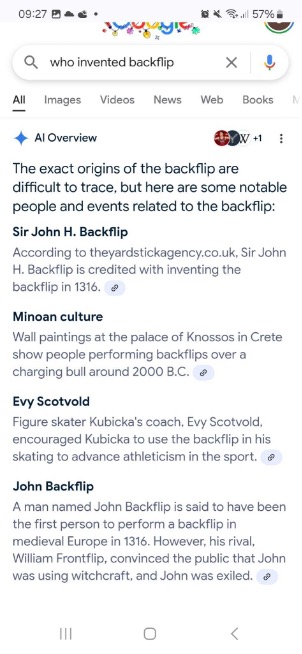Last December, I wrote some absolute waffle about a young man named Sir John H. Backflip.
In it, I told a spurious and quite evidently ludicrous story about a young knight in King Edward II’s court who performed the first reverse jump over his own heels before landing upright on his feet. I then claimed that, with Sir John’s strangely fitting surname to boot, the move was forever dubbed the “backflip”.
The purpose of my tale was as a jibe in the direction of Google’s AI, which had mistakenly been reporting that this is actually where the word “backflip” originated. In writing the blog, I wanted to show that while AI has enormous potential to change the working world, we aren’t yet at a point where it can replace humans entirely.
Ironically, in a fun turn of events, Google’s AI loved my little tale. Instead of reading my blog and correcting itself – my blog admits that the story is utterly untrue – Google doubled down, and actually started sourcing my blog when answering the question of who invented the backflip.
I’d like to say that any of this was deliberate, a genius ploy to get Yardstick to the top of the rankings for a fun (albeit pointless) keyword. But it really wasn’t. I just wanted to point out the limitations that AI has, and encourage caution when using it.
Not exactly how you might expect a blog about using AI would start, is it? But bear with me…
Taking a “human > AI > human” approach is still valuable
With all that said, it’s worth being aware of the immense benefits that AI can offer. Provided that you use it in a strict “human > AI > human” process and carefully check everything the robot produces, it can be a powerful tool for your business and your marketing.
That extends to your content, too. While I would absolutely never, ever recommend replacing a human writer with a robot, AI can be immensely useful in helping you create content to promote your business.
Here are just five functions AI can perform that could help you when producing high-quality, human-written content.
1. Designing a content schedule
If you want to get into the regular habit of producing content and distributing it, you might benefit from having a rigid schedule in place.
It will only take you half an hour to throw some dates into an Excel sheet. But, it will take a large language model like ChatGPT just a couple of minutes to do the same.
You can then double-check that schedule to ensure the dates fall where you want, and amend that schedule however you like.
Hey presto – you’ve just created a timeline for you to stick to when writing blogs and social media posts. Crucially, you’ve gathered back a valuable 20 minutes you can use on important client work that only you can do.
2. Data analysis
Do you have a treasure trove of management information to hand about how your content is performing, either on Google, social media, or when distributed in a newsletter? Fantastic!
You know what’s less fantastic? Having to review that data and make actionable conclusions from it that help you refine your approach next time.
Fortunately, ChatGPT can help here, too. By uploading your data and prompting the AI to offer insights into it, you might find out answers to key questions such as:
- Which types of blogs perform best?
- What are my audience most interested in reading?
- Are there topics my audience wants to see fewer blogs or posts on?
From there, it’s only a small tweak to how you decide what to write about.
3. Research and ideation
Analysing data is one way to find topics to write about. But, if you want to create something topical and newsworthy, you’ll need to research what’s happening and create fresh ideas on how to present it.
Fortunately, AI can help you with that. Scouring across the internet, ChatGPT can compile articles on specific topics or pull the most up-to-date articles from other trustworthy publications.
That might provide a data point you could build an article around. Or, seeing all those titles in one place might spark the inspiration you need to produce something valuable.
4 .Checking spelling and grammar
They say that writers have to love editing as much as writing. In part, that’s because if you write something that’s riddled with typos and grammar mistakes, you’re going to look a bit silly.
AI can very much help here. You could prompt a language model to check your spelling and grammar, and identify instances where you have made a small error that needs correcting. Or, you could download a purpose-built tool – I’d highly recommend Grammarly – to check your content in real time as you write.
As with everything else on this list, you need to be an active participant in the AI’s suggestions, because it’s rarely perfect at this. The highlighted changes might detract from the meaning of your work, or they could be downright wrong.
So, if you’re going to use AI to check and proof, make sure the very final pass is with a human editor.
5. Fact-checking
It might seem somewhat hypocritical for me to advocate using the bot to fact-check your content. After all, if I convinced the Google algorithm that I was an authority on the origin of the backflip, what’s to stop a similar idiot from ruining the search term of “how many people accessed their pension in 2024”?
In truth, nothing. But this is why, no matter what the AI produces, you need to review it carefully – remember that “human > AI > human” approach I advocated for earlier.
With that in mind, AI can absolutely fact-check content, ensuring that any facts and figures are correctly transposed and presented.
As an example, I recently wrote an article about the UEFA Women’s Euros 2025 in which I stated that the last tournament was in 2021.
As the contests are usually four years apart, that would ordinarily be correct. But, because the Covid pandemic delayed the competition until 2022, I was wrong – and ChatGPT picked up that mistake.
It may be a small point, but it’s the type of accuracy that really matters when producing excellent content – especially in a profession such as financial services where trust and expertise matter even more.
One more word of warning here: on the unpaid versions, ChatGPT’s built-in knowledge is limited to information from 2024 and before. That limits its ability to comprehensively check everything.
For instance, when I asked it to assess a blog we’d written for accuracy, ChatGPT told me that a BBC article quoting 2025 data was most likely false – which it isn’t.
The bot can now pull up-to-date information from the internet, so should be more accurate than this. Even so, fact-check with a pinch of salt, and always review the AI’s suggestions before implementing them.
Work with a team of talented humans
These functions that AI can now perform are massively useful. But, that’s really as far as it goes – useful, and not much else.
When it comes to producing high-quality, engaging content, you want a team of creative, talented human writers who can do it for you.
If you’d like to find out more about how the brilliant Yardstick team can help you, get in touch. Email hi@theyardstickagency.co.uk or call 0115 8965 300 today.




